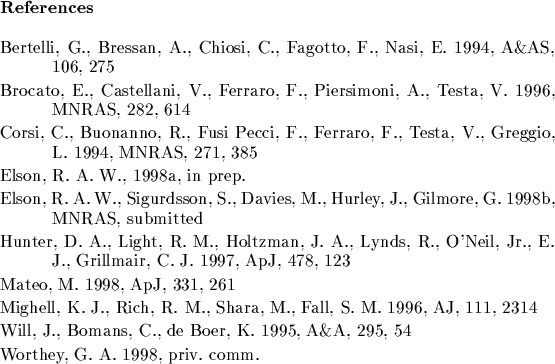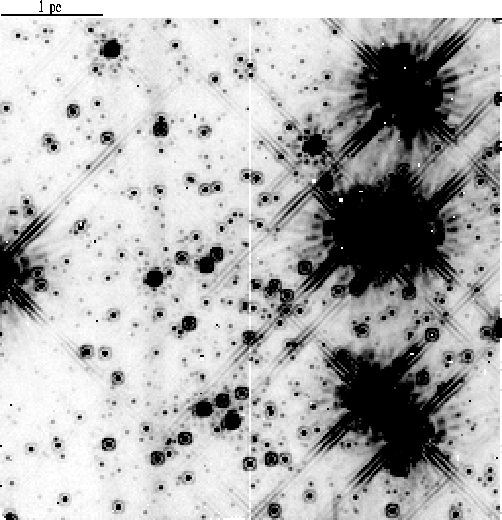 |
B.Santiago Universidade Federal do Rio Grande do Sul, Porto Alegre, Brazil
http://www.ast.cam.ac.uk/LMC
LMC, globular clusters
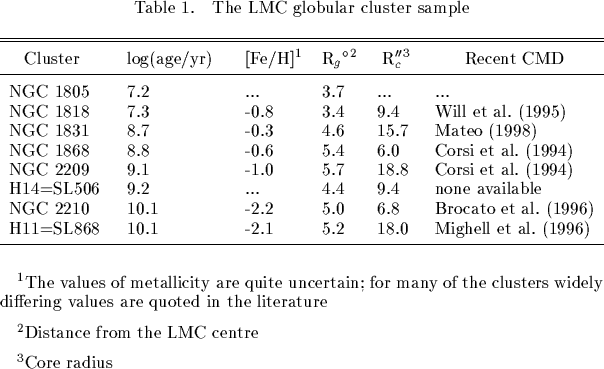
Our observing strategy is to obtain HST images of two fields in each cluster, one field at the cluster core and one at the half mass radius. HST images of both regions are taken with WFPC2 (F555W and F814W) and NICMOS (F160W). STIS images are also taken at the half mass radius. We obtained 95 orbits of Cycle 7 HST time (PID 7307) and hope to have all the data by the end of the year.
Current N-body codes are now capable of modelling realistic systems with 104 stars. We aim to combine our HST observations with N-body models to understand the formation and evolution of globular clusters. A detailed discussion of the aims of this LMC project is given in Elson et al. (1998a). In brief, we will use the young clusters to constrain the star formation timescale (see below for an example) and also to look for evidence of sequential star formation (e.g. did low mass stars form first ?). Binaries play a crucial role in cluster evolution and we will be able to place firm observational constraints on the binary fraction at various evolutionary stages. Using our very deep STIS images we will construct initial mass functions (IMFs). If there is a universal IMF then a minimal expectation would be that the younger LMC clusters, with very little dynamical evolution, a wide range of stellar masses, and in some cases very similar metallicities, should have indistinguishable mass functions.
The same procedure for obtaining the photometry was followed in the optical and in the near-infrared. The IRAF package DAOPHOT was used. Firstly the task DAOFIND was used to detect stars on the image, and aperture photometry was obtained for these stars. A point spread function (psf) was constructed from bright stars in the image. All the stars in the image were then fitted with the psf. The psf fitting diagnostics (chi and sharpness) were used to exclude non-stellar objects to produce the final star list. To construct the colour-magnitude diagrams we have used aperture photometry of this final star list.
The many diffraction spikes, especially in the NICMOS image, could be affecting the magnitudes of some of the stars and introducing a scatter in the colours. All the stars in the final star list have therefore been visually inspected on both the images. Those that appear to be affected by the diffraction spikes of bright neighbours, or that are very close to a bright star, have been removed.
An estimate of the maximum error in the H160 magnitude of the bright stars due to the varying underlying background showed that the psf fitting errors gave a good estimate of the error. The V555 errors are poisson errors.
Figure 2 shows the V555 vs. V555-H160 colour-magnitude diagram for the central regions of NGC 1818. Overplotted on the data are isochrones for [Fe/H]=-0.7 with ages of 25, 40, 63 and 159 Myr. The isochrones are from Bertelli et al. (1994) with magnitudes calculated for the HST passbands (Worthey 1998) and have been shifted to a distance modulus of 18.5 and reddened by E(B-V)=0.05. The H160 data have not been photometrically calibrated and so an arbitrary x-axis shift has been applied to align the data with the isochrones. It can be seen from the position of the isochrones that age spreads in the cluster will be apparent for V555<19. Figure 3 zooms in on this region.
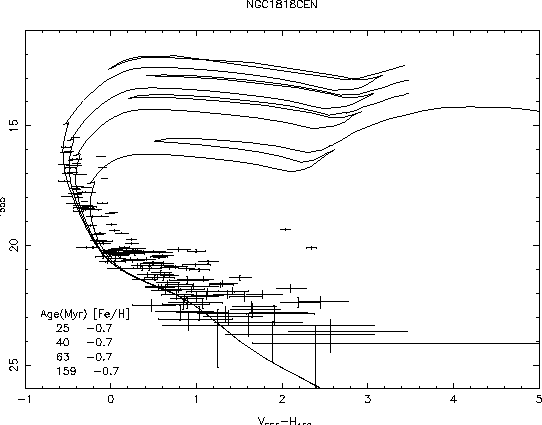 |
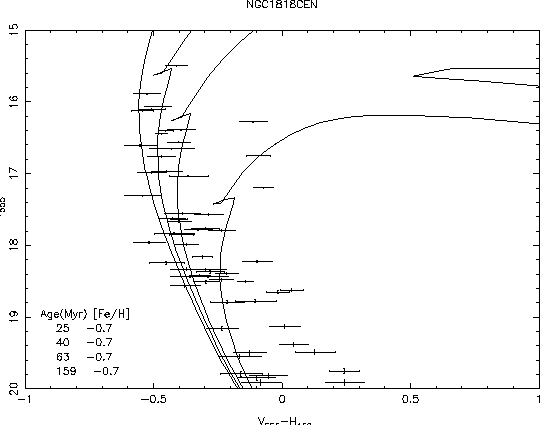 |
Other possible causes of a spread in the colour magnitude diagram are
background field star contamination and the presence of cluster
binaries. From the background field presented in Hunter et al. (1997) we estimate that one of the stars with V555<18, and one of
the stars with 18
<V555<19 could be background stars.
For V555>19 it is not possible to estimate the background star
contamination from Hunter et al. (1997). NGC 1818 contains a binary
star population (Elson et al. 1998b), with the majority of binaries
having a secondary mass > 70% of the primary mass. In this case
the observed binary sequence lies along the equal mass binary
sequence. Figure 4 plots the position of an equal mass
binary sequence for the 25Myr and 63 Myr isochrones. Although some of
the spread in stars with V
![]() 18 could be due to binaries,
this is not the case for the brighter stars.
18 could be due to binaries,
this is not the case for the brighter stars.
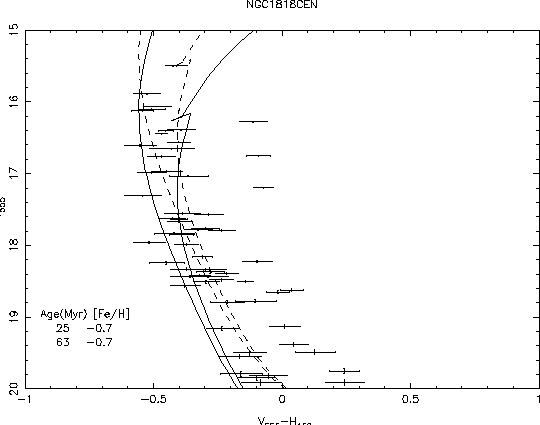 |
Figure 3 contains three bright stars (V555<18) which lie to the right of the 63Myr isochrone. As mentioned above these stars have been inspected in both the V555 and H160 images for underlying diffraction spikes or neighbouring bright stars which may be affecting their magnitudes. They lie close to the 169 Myr isochrone. This is much to old for them to be cluster members. As mentioned above the background field star contamination at these magnitudes should be negligible. However there is always the possibility that we are unfortunate enough to be looking at a background clump of stars. Analysis of our own background fields and parallel data will enable us to place better limits on the expected number of background stars at each magnitude.
There are several stars with V555 around 19 which have very red colours. Again, it is possible that these are field stars and/or background galaxies.
The rest of the stars with V555<18 appear to lie mostly within
the 20-63 Myr isochrones. There is tentative evidence here for an age
spread of some 40Myr. However, we need to run simulations to quantify
how much of this spread is due to photometric errors. The crossing
time at the half mass radius of NGC1818 ![]() 10Myr. If the 40Myr
age spread is real then it is several times greater than the crossing
time which has implications for the process of star formation in the
progenitor cloud. We explore these implications further in a future
paper.
10Myr. If the 40Myr
age spread is real then it is several times greater than the crossing
time which has implications for the process of star formation in the
progenitor cloud. We explore these implications further in a future
paper.
